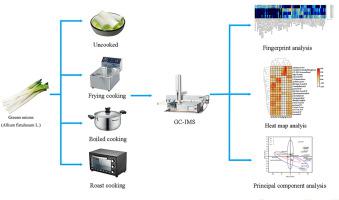当前位置:
X-MOL 学术
›
Int. J. Gastron. Food Sci.
›
论文详情
Our official English website, www.x-mol.net, welcomes your feedback! (Note: you will need to create a separate account there.)
Comparative study of volatile flavor compounds in green onion (Allium fistulosum L.) processed with different cooking methods
International Journal of Gastronomy and Food Science ( IF 3.2 ) Pub Date : 2024-01-17 , DOI: 10.1016/j.ijgfs.2024.100878 Jicai Bi , Bian Li , Zhuo Chen , Zhen Yang , Chunyuan Ping , Yueyue Gao , Yao Zhang , Lingwen Zhang
International Journal of Gastronomy and Food Science ( IF 3.2 ) Pub Date : 2024-01-17 , DOI: 10.1016/j.ijgfs.2024.100878 Jicai Bi , Bian Li , Zhuo Chen , Zhen Yang , Chunyuan Ping , Yueyue Gao , Yao Zhang , Lingwen Zhang

|
The characteristic aroma of green onions was effective in masking the fishy smell in dishes and enhancing the overall flavor. The study aimed to isolate and identify the volatile compounds present in raw, boiled, fried, and roasted green onions using gas chromatography-ion migration spectrometry (GC-IMS). The relative odor activity value (ROAV) was determined, and principal component analysis (PCA) was used to analyze the elements. A total of 64 volatile compounds were finally identified from the green onions and classified as sulfur compounds (19 species), aldehydes (14 species), alcohols (12 species), ketones (13 species), esters (5 species), and furans (1 species). The results of fingerprint analysis indicated that the unique flavor of raw green onions could be attributed to sulfur compounds such as allyl methyl trisulfide and diethyl trisulfide. The unique flavor of boiled green onions can be attributed to the presence of aldehydes such as E-2-octenal and E-2-heptenal. The characteristic flavor components of fried green onions were 3-methyl-butanol and 2-methyl-butanol. Roasted green onions contained ketones, including 2-Butanone and 3-Pentanone, which contributed to their unique flavor. The results of the principal component analysis (PCA) indicated that the flavor of boiled and fried green onion was similar, while a significant difference was observed between raw and roasted green onions.
中文翻译:

不同烹调方法加工大葱挥发性风味物质的比较研究
大葱特有的香气能有效掩盖菜肴的腥味,提升整体风味。该研究旨在使用气相色谱-离子迁移光谱法 (GC-IMS) 分离和鉴定生洋葱、煮洋葱、油炸洋葱和烤洋葱中存在的挥发性化合物。测定相对气味活性值(ROAV),并采用主成分分析(PCA)对元素进行分析。最终从大葱中鉴定出64种挥发性化合物,分别为硫化合物(19种)、醛类(14种)、醇类(12种)、酮类(13种)、酯类(5种)和呋喃类化合物。 1 种)。指纹图谱分析结果表明,生葱的独特风味可能归因于烯丙基甲基三硫醚、二乙基三硫醚等硫化合物。煮葱的独特风味可归因于醛类的存在,例如E-2-辛烯醛和E-2-庚烯醛。炸葱的特征风味成分是3-甲基丁醇和2-甲基丁醇。烤大葱含有酮类,包括2-丁酮和3-戊酮,这有助于其独特的风味。主成分分析(PCA)结果表明,煮葱和炒葱的风味相似,而生葱和烤葱的风味差异显着。
更新日期:2024-01-17
中文翻译:

不同烹调方法加工大葱挥发性风味物质的比较研究
大葱特有的香气能有效掩盖菜肴的腥味,提升整体风味。该研究旨在使用气相色谱-离子迁移光谱法 (GC-IMS) 分离和鉴定生洋葱、煮洋葱、油炸洋葱和烤洋葱中存在的挥发性化合物。测定相对气味活性值(ROAV),并采用主成分分析(PCA)对元素进行分析。最终从大葱中鉴定出64种挥发性化合物,分别为硫化合物(19种)、醛类(14种)、醇类(12种)、酮类(13种)、酯类(5种)和呋喃类化合物。 1 种)。指纹图谱分析结果表明,生葱的独特风味可能归因于烯丙基甲基三硫醚、二乙基三硫醚等硫化合物。煮葱的独特风味可归因于醛类的存在,例如E-2-辛烯醛和E-2-庚烯醛。炸葱的特征风味成分是3-甲基丁醇和2-甲基丁醇。烤大葱含有酮类,包括2-丁酮和3-戊酮,这有助于其独特的风味。主成分分析(PCA)结果表明,煮葱和炒葱的风味相似,而生葱和烤葱的风味差异显着。




































 京公网安备 11010802027423号
京公网安备 11010802027423号